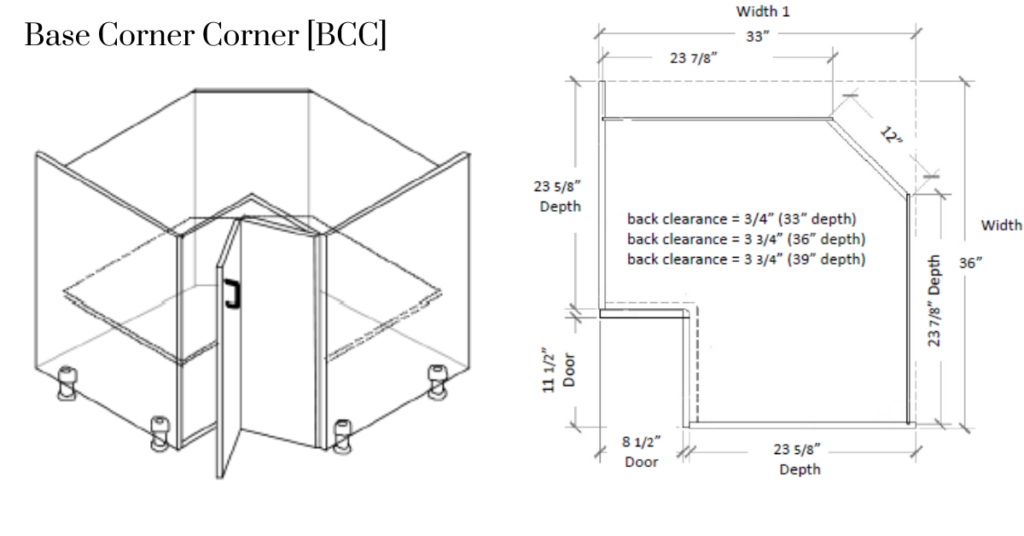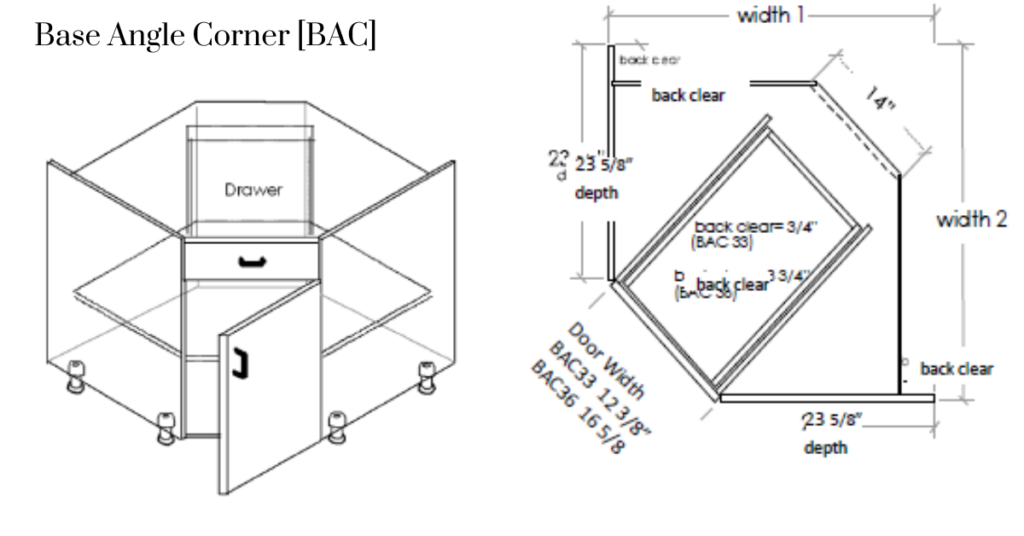Unless you have a Galley Kitchen, most kitchen designs have 1-2 corner areas as part of their layout plan. If you don’t fill the space with a built in corner pantry, you will probably want a cabinet. There are a few ways to fill the space, let’s discuss the various options.

BASE CORNER CORNER
The Base Corner Corner, also known as the BCC, is a very commonly used corner cabinet in kitchen design. It features a bifold door design made up of 2 doors, connected with a knuckle hinge. The doors swing open and allows them to lay flat, or almost flat, on the hinged side. They come in many sizes, the most standard being 33”, 36”, and 39” and can be hinged either right or left. Larger BCC cabinets have wider openings, which improves accessibility to the inside and smaller ones will have the opposite, so keep that in mind when planning.

The standard Base Corner Corner is typically equipped with an adjustable shelf inside, depending on the cabinet manufacturer. Some companies also add the option to add more shelves at the design stage for an upcharge, which is a great lower cost upgrade option to consider. Interior shelves offer a very nice weight capacity for heavier items.

Popular Accessories
There are many accessories available for this cabinet, but some variation of a Lazy Susan has been the most popular for probably the last 30 years. On the basic side, the White Acrylic Pie Cut Lazy Susan is a nice option. On the mid-range side, the Wooden Pie Cut Lazy Susan is fantastic. As a deluxe upgrade option, most homeowners choose the Wood Super Susan, which has almost become a staple item in modern kitchens of today.
While there are a few other Lazy Susan Alternatives, many of them just aren’t as popular. One of those unpopular accessories would include the 3 Bin Corner Recycle Centre, which just didn’t take off as expected.
BASE BLIND CORNER
The Base Blind Corner, or known as a BBC to kitchen designers, has gained in popularity over the past 10 years in certain markets, as kitchen designs become more streamlined. The Base Blind Corner typically has 1 Door, known as a full height, or 1 Door and 1 Drawer. It comes hinged left or right and the door typically opens to 95 degrees. The blind panel is usually finished to match the cabinet door, or very close to it. This cabinet typically comes standard with an adjustable shelf, perfect for heavy items. You can also add more shelves in the planning and design stage for an extra cost.

Common or standard sizes of the cabinet are 39”, 42”, 45”, and 48”. Remember, this cabinet does take up more footprint area than the cabinet size in a design, as it is recommended to install this cabinet pulled forward 1”- 3” away from the wall corner, for a better fit.

Some homeowners that have lived with smaller Base Blind Corners may be turned off by them, as the entry opening can be very small and hard to access items stored inside, which is why almost all homeowners upgrade and add a pull-out accessory.
Popular Accessories
Some Professional Kitchen Designers may tell you that many homeowners choose a Base Blind Corner in their designs just for the pullout accessory options. On the budget side, the White Acrylic Half Round Lazy Susan is a decent choice, however the lower lip or edge can make items prone to falling down if opened too fast. For a deluxe upgrade options, the LeMans II Twin Corner Storage Unit and Magic Corner Storage Unit are the most popular choices.


CORNER DRAWERS
Most people can remember the first time they had the opportunity to experience corner drawers in person, it’s a never forget moment. Corner Drawers challenge thinking about how a corner in a kitchen can and should be used, because they are so innovative. Base Corner Drawers typically come in a 3 Drawer Configuration, sizes include 36” and 42”. [UPDATE – The Superior Cabinets Corner Drawer Cabinets now has upgraded Solid Birch Wood Drawers, as the Metal sides have been discontinued].

They deliver an amazing ergonomic experience, great for aging in place, and are packed with an abundance of storage capacity. They are at the highest price point, due to the incredible amount of work and materials cost to build them, so keep that in mind as you set your cabinetry allowance.

BASE ANGLE CORNER
The Base Angle Corner, also known as the BAC is another corner cabinet option. They come in a one door [full height] or a 1 door/1 drawer configuration, in left or right hinging options, with 95 degree hinging/opening capability. Standard sizes include 33” and 36”. This cabinet typically comes with one full depth adjustable height shelf, but more can be added as an upgrade before you order. There is also a full height version that can be used for a corner sink cabinet, which can be a nice option for some designs.

The Superior Cabinets Kitchen Experts have noticed a huge decline in popularity for the Base Angle Corner Cabinet over the past 10 years. This would mostly be attributed to the fact that other cabinets, as previously mentioned, have better options for pull-out accessories that make items easier to reach. There are virtually no standard accessories or pullouts available for this cabinet, which is another drawback.

Another reason for the decline in the BAC’s popularity is because of the angled front. Angles in kitchen design typically cost you more money. For Full Access / Frameless Cabinets, there are often extra filler pieces required on each side of the BAC cabinet, resulting in more millwork and installation costs. Another consideration would be increased countertop costs, as capping off the corner angle with a piece of Quartz or Granite is far more expensive, due to the required slab size to fulfill the angle.
Yikes! A Void Corner? Why would you do that? This can be a controversial topic between homeowners and kitchen designers. Your professional cabinet designer will know when this is the right thing to do in a space. Voiding a corner is often used when either a range or sink needs to be nested closely into a corner, as the smallest functional corner cabinet takes up about 33” of space. There are some designs where using a 33” corner cabinet is prohibitive or impossible, so voiding the corner should be considered in these scenarios.
VOID CORNER

Another reason to use a void corner, is to obtain a larger drawer bank, often reserved for pots and pans. Although this seems counterproductive to close off space to gain more elsewhere, it can work. This is typically more so common in smaller design plans, but not limited to.
If your cabinet designer suggests voiding a corner, hear them out, as there may be some big advantages of doing this. If you are the type that can’t stand having unused space, that is completely inaccessible, do not consider this option.
SUMMARY
Using corner cabinets in a kitchen design is almost unavoidable unless you have a straight galley kitchen or void your corner. Average kitchens can have 1-3 corners so it’s important that they are well-planned for your needs and accessibility requirements. Don’t forget about designing for today and tomorrow, as a good kitchen should last you about 20 years, and your needs will change as you get older.
Work with a professional kitchen cabinet designer to help you plan for your needs and budget. Superior Cabinets has kitchen and bath designers in Calgary, Edmonton, Regina, Saskatoon, and Winnipeg. If you would like to chat with them, please get in touch by booking an appointment online. If you aren’t close to a Superior Cabinets corporate store, be sure to find a Superior Cabinets Authorized Dealer Partner near you in Canada or the United States.
LOOKING FOR MORE?
Here are some additional helpful articles to check out:
2024 KITCHEN TRENDS
5 LAZY SUSAN ALTERNATIVES
WAYS TO SAVE MONEY ON NEW KITCHEN CABINETS
WHAT DOES AN AVERAGE KITCHEN COST?
KITCHEN DESIGNER CHEATSHEET
THE KITCHEN CABINET BUYER’S GUIDE
CHOOSING THE BEST DRAWER SYSTEM
FARMHOUSE SINK CONSIDERATIONS
ACTING AS YOUR OWN GENERAL CONTRACTOR, WHAT YOU NEED TO KNOW
ADDING TO EXISTING CABINETS
THE SLIM SHAKER DOOR… JUST A TREND… OR IS IT HERE TO STAY?
RUSTIC ALDER CABINETS, THINGS TO CONSIDER
Stay in the loop and subscribe today to the Superior Cabinets Email News Bulletin.
